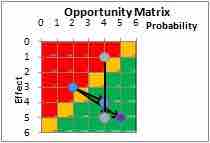Ansoff Opportunity Matrix
The Ansoff Opportunity Matrix was created by Igor Ansoff as a way to create growth strategies for corporations based on markets and products . According to Ansoff, there are four possible combinations:

Product/Market Ansoff matrix
Companies can choose their growth strategies based on the type of market (new or old) they wish to pursue and the type of product (new or old) they wish to propagate.
- Marketing penetration - This growth strategy uses current products and current markets with the goal to increase market share.
- Market development - This growth strategy uses existing products to capture new markets.
- Product development - This growth strategy uses new products in the existing market.
- Diversification - This strategy creates completely new opportunities for the company by creating new products and new markets.
A company should decide which strategy to use based on the strengths and weaknesses of the company and its competitors. Each strategy has a different level of risk, with market penetration having the lowest risk and diversification having the highest risk .

Opportunity Matrix
An opportunity matrix can be used by a company to identify opportunities.
Market Penetration
This occurs when a company infiltrates a market in which current products already exist. The best way to achieve this is by gaining the customers of competitors. Other ways include attracting non-users of your product or convincing current clients to use more of your product.
The penetration that brands and products have can be recorded by companies such as ACNielsen and TNS who offer panel measurement services to calculate this and other consumer measures. In these cases, penetration is given as a percentage of a country's households who have bought that particular brand or product at least once within a defined period of time.
While market penetration may come with the lowest risk, at some point the company will reach market saturation with the current product and will have to switch to a new strategy, such as market development or product development.
Market Development
Market development targets non-buying customers in currently targeted segments. It also targets new customers in new segments in order to expand the potential market. New users can be defined as: new geographic, demographic, institutional, or psychographic segments. Another way is to expand sales through new uses for the product.
Before developing a new market, companies should think about the following: Is it profitable? Will it require the introduction of new or modified products? Is the customer and channel researched and understood?
If a company believes that their strength lies with their products and they believe their products would be enticing to new customers, then a company may want to use a market development strategy.
New Product Development
New product development is a process that has two parallel paths: one involves the idea generation, product design, and detail engineering; the other involves market research and marketing analysis. A product is a set of benefits offered for exchange and can be tangible (that is, something physical you can touch) or intangible (like a service, experience, or belief). Companies typically see new product development as the first stage in the overall strategic process of product life cycle management used to maintain or grow market share.
If a company believes that their strength lies with the customers, then they should consider a product development strategy.
Diversification
Diversification seeks to increase profitability through greater sales volume obtained from new products and new markets. At the business unit level, diversification is most likely to expand into a new segment of an industry that the business is already in. At the corporate level, it is generally via investing in a promising business outside of the scope of the existing business unit. Ansoff pointed out that a diversification strategy stands apart from the other three strategies.
The first three strategies are usually pursued with the same technical, financial, and merchandising resources used for the original product line, whereas diversification usually requires a company to acquire new skills, new techniques, and new facilities.
Because of the high risk involved with diversification, many marketing experts believe a company shouldn't attempt diversification unless there is a high return on investment and their SWOT analysis makes them feel that they have a chance of succeeding in the new market with a new product.